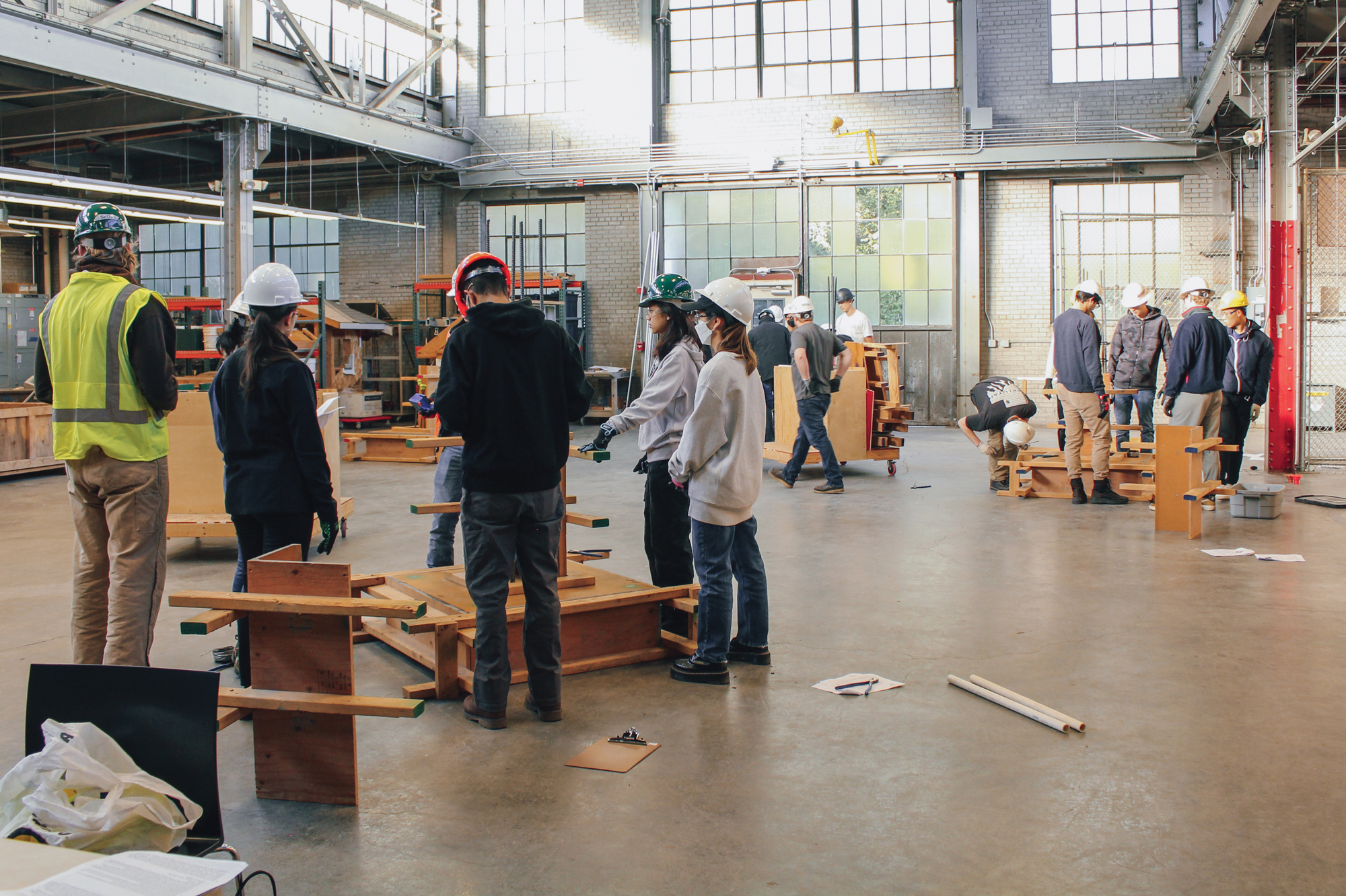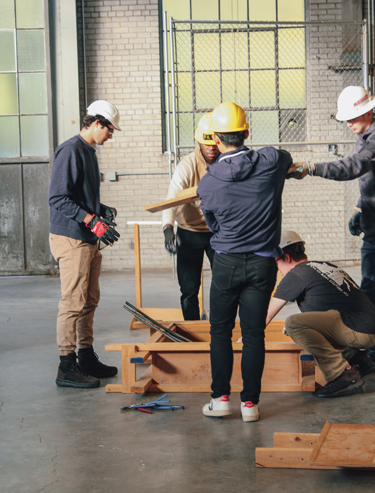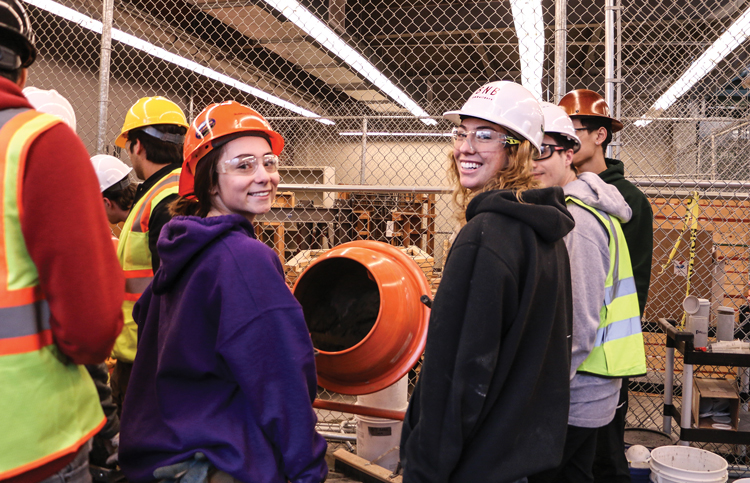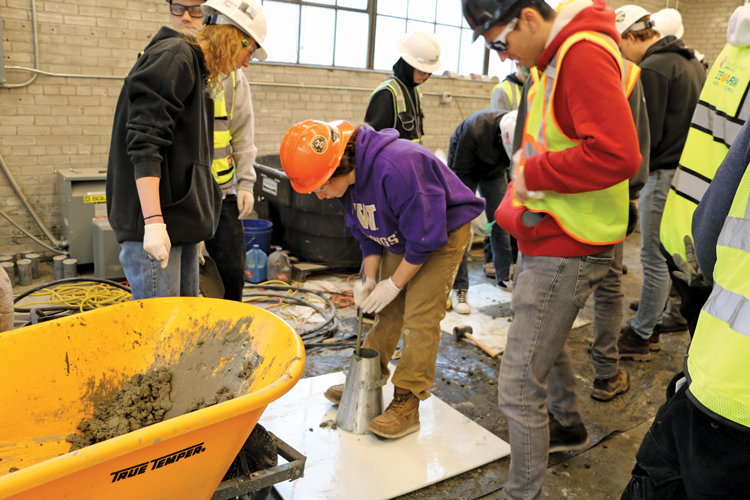Mix masters Mix masters Mix masters
At a UW lab, students are testing ways to give concrete a solid future.

At a UW lab, students are testing ways to give concrete a solid future.
Nestled in a former airplane hangar in the sprawling former Navy base at Magnuson Park, construction and engineering students from the University of Washington stress-test recipes for concrete—one of the world’s most used substances. Made with a combination of cement, water and aggregates, some type of concrete has been produced by every civilization since the Babylonians. Now, university students are joining in the centuries-long quest to refine and perfect this essential material at the University of Washington Center for Education and Research in Construction (CERC).
Dr. Fred Aguayo, who joined the faculty of the College of Built Environments in 2021, is the director of the Construction Methods and Concrete Materials Laboratory (which Aguayo has dubbed CM2L), as well as an assistant professor with the Department of Construction Management and an adjunct assistant professor with the Department of Civil and Environmental Engineering. You could say he enjoys watching cement “dry”—but of course he’s heard that one before. Since joining the UW, it’s his expertise in the field that has allowed more of a focus into concrete and its potential.

The goal of the UW Construction Methods and Concrete Materials Lab is to become a resource for the construction industry as a certified materials testing ground.
The lab, while surprisingly tidy for a place that sees concrete smashed daily, is very much a working environment—something that Aguayo takes pride in. “Don’t expect to wear a white coat,” he says, smiling wide. “Any student coming through here, whether doing research or course lab experiments, will benefit from working so hands-on going into the construction industry.” The construction materials lab also is a key resource for other UW units, such as architecture, civil and environmental engineering, and chemistry and materials science students. The lab is a place where project samples from these and other departments can be brought to be tested, and then scaled up to real proportions within the hangar’s lofty heights. From undergraduate to doctoral students, this cross-college collaboration is another thing Aguayo appreciates about the work done in the lab. As one of the state of Washington’s only academic experts actively researching concrete materials and their durability, Aguayo has a unique specialty that allows students to see and participate in the future of the concrete construction industry.
Research into cement-based systems of infrastructure is good news for the estimated 4.1 billion tons of cement produced globally, mostly in China. Potential innovations in material durability, alternative and supplementary cement binders, recycled aggregates and high-performing concrete are the keys to improving environmental sustainability, safety and longevity.
Sustainability, notes Aguayo, is one of the things he sees as foremost on the minds of the students who come through the lab. As the Pacific Northwest continues to lead the pursuit of more environmentally responsible materials and methods, innovations in this area cannot come soon enough. Burning limestone to obtain lime, one of the main components of ubiquitous Portland cement, creates CO2, and the cement-making process has been attributed as one of the leading causes of human-made CO2, often cited as around 9% of its global production. While extending the lifespan of the sturdy stuff is one of the main solutions to cutting down on production, as well as discovering more effective outcomes of recycling it, alternative and more environmentally friendly cements are a central focus of Aguayo’s research into the next generation of concrete materials.

It’s a great thing that students are getting hands-on experience making construction materials. Approximately 11,000 lane miles of roads in Washington state require repair.
For example, using ground limestone to partially replace Portland cement can reduce its carbon footprint and be an effective strength-promoting filler. Known as Portland Limestone Cements, it is one of the current “hot” topics in the concrete industry, Aguayo says. An unintended (but positive) consequence of burning less coal than in previous decades is the reduced availability of coal fly ash, a byproduct of coal burning and one of the most used supplementary binders in making concrete. Completely alternative cementitious materials such as calcium sulfoaluminate (CSA) cement are beginning to gain attention for their remarkably fast strength-gaining properties, superior durability and lower CO2 footprint than ordinary Portland cement and other infrastructure materials. Imagine the difference in construction timelines with concrete that cures faster, is just as durable (or more durable) and more environmentally friendly. “CSAs can develop most of their design strength in as little as three to four hours, for what would normally take days or weeks in traditional Portland cement binder,” says Aguayo. It’s these types of alternative or supplemental binders that represent a big opportunity in cement and concrete research and would be game-changing for the construction industry.
And innovations in concrete could benefit repairs even more in new construction. Infrastructure such as roads, bridges, utilities and dams are among the enduring repair challenges for cities and states. Seattleites’ daily confrontations with potholes and corroded concrete should spotlight the understanding of the shortcomings of this material as we know it. According to the Washington State Department of Transportation, about 11,000 lane miles of roads in the Evergreen State require repair. Part of the 2022 “Move Ahead Washington” infrastructure package ($3 billion over 16 years) will address numerous repairs and expansions. Longer-lasting concrete could mean fewer maintenance crises.

Students try out new recipes for making concrete, such as replacing Portland cement with ground limestone. That could yield a product with excellent strength and a reduced carbon footprint.
Meanwhile, the UW Construction Methods and Concrete Materials Lab continues to build on its importance. Giovanni Migliaccio, chair and professor of the Department of Construction Management and executive director of the UW Center for Educational Research in Construction, predicts that in six to eight years, the lab can serve the construction industry as a certified testing ground, supporting so many of the local companies that already lend their expertise to the students in the form of the department’s advisory council. “We have nearly 40 companies and associations that support our mission through mentoring, internships and scholarships. They also support when classes need a site visit, guest lecturer, coaches for a competition or occasional special needs like software and equipment,” Migliaccio explains. The mix of research and real-life industry involvement has immeasurably increased the department’s and college’s profiles, and it’s only growing. To wit, Migliaccio says their programs have seen a substantial increase in both master’s student applications and undergraduate interest, especially among high school graduates who apply to the UW and list the major as their first or second choice.
The playfulness of undergraduate experiments, Aguayo reveals, is the lighter side of working with this heavyweight substance. One student, he recalls, used broken glass from a bottle as the “rock” in a mix of white concrete to make some coasters and concrete countertops. Not as a strength experiment, but to make it look cool. And it worked. Perhaps the next college to get in on the lab’s creation capabilities will be art.
Whether churning out decorative or cutting-edge alternative concretes, the CERC continues to evolve and grow. UW concrete is making a great case for being the foundation of the future.